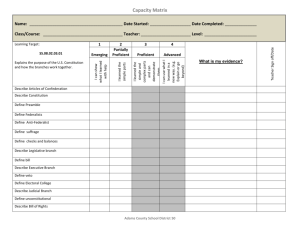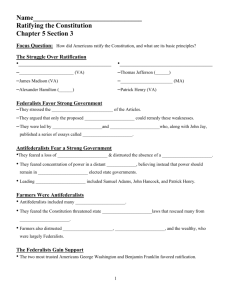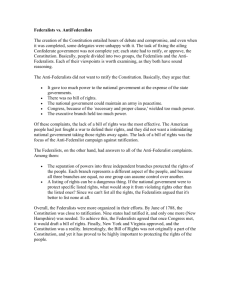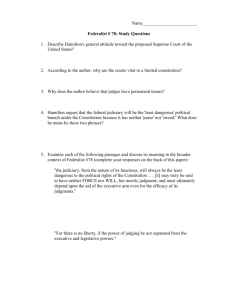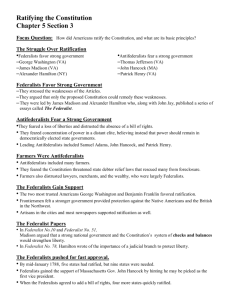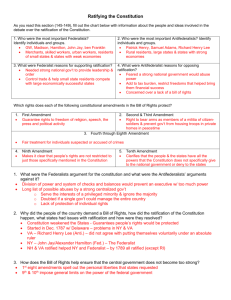Ratifying the Constitution: Federalists vs. Antifederalists
advertisement
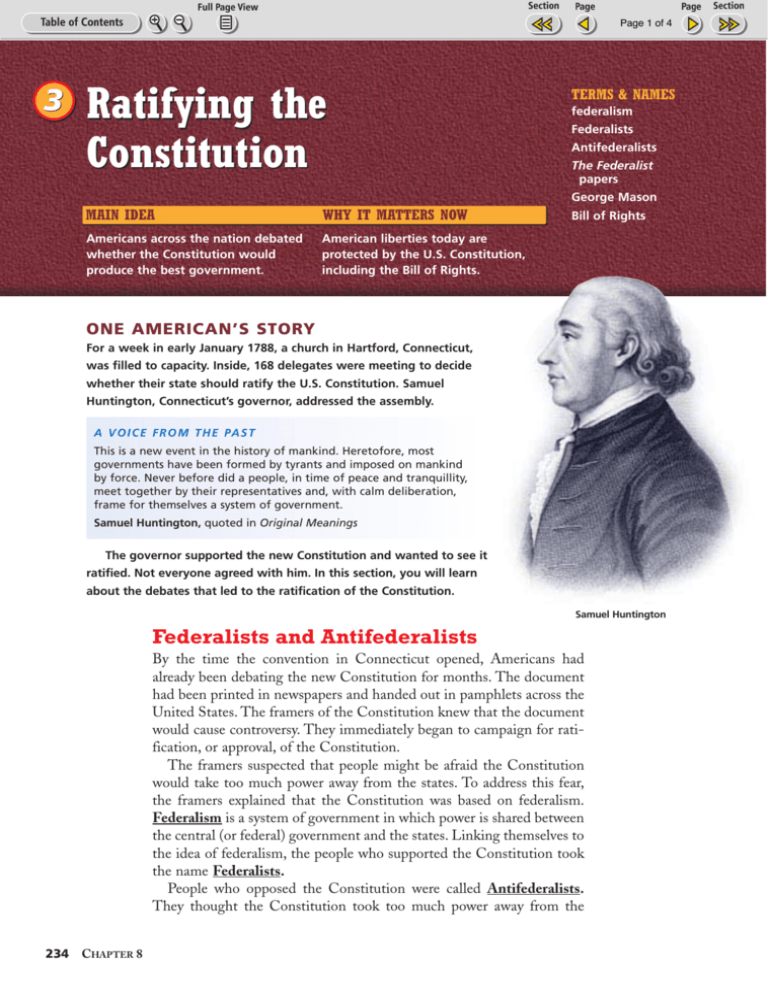
Page 1 of 4 3 Ratifying the Constitution TERMS & NAMES federalism Federalists Antifederalists The Federalist papers George Mason MAIN IDEA WHY IT MATTERS NOW Americans across the nation debated whether the Constitution would produce the best government. American liberties today are protected by the U.S. Constitution, including the Bill of Rights. Bill of Rights ONE AMERICAN’S STORY For a week in early January 1788, a church in Hartford, Connecticut, was filled to capacity. Inside, 168 delegates were meeting to decide whether their state should ratify the U.S. Constitution. Samuel Huntington, Connecticut’s governor, addressed the assembly. A V O I C E F R O M T H E PA S T This is a new event in the history of mankind. Heretofore, most governments have been formed by tyrants and imposed on mankind by force. Never before did a people, in time of peace and tranquillity, meet together by their representatives and, with calm deliberation, frame for themselves a system of government. Samuel Huntington, quoted in Original Meanings The governor supported the new Constitution and wanted to see it ratified. Not everyone agreed with him. In this section, you will learn about the debates that led to the ratification of the Constitution. Samuel Huntington Federalists and Antifederalists By the time the convention in Connecticut opened, Americans had already been debating the new Constitution for months. The document had been printed in newspapers and handed out in pamphlets across the United States. The framers of the Constitution knew that the document would cause controversy. They immediately began to campaign for ratification, or approval, of the Constitution. The framers suspected that people might be afraid the Constitution would take too much power away from the states. To address this fear, the framers explained that the Constitution was based on federalism. Federalism is a system of government in which power is shared between the central (or federal) government and the states. Linking themselves to the idea of federalism, the people who supported the Constitution took the name Federalists. People who opposed the Constitution were called Antifederalists. They thought the Constitution took too much power away from the 234 CHAPTER 8 Page 2 of 4 Vocabulary aristocracy: a group or class considered superior to others states and did not guarantee rights for the people. Some were afraid that a strong president might be declared king. Others thought the Senate might turn into a powerful aristocracy. In either case, the liberties won at great cost during the Revolution might be lost. Antifederalists published their views about the Constitution in newspapers and pamphlets. They used logical arguments to convince people to oppose the Constitution. But they also tried to stir people’s emotions by charging that it would destroy American liberties. As one Antifederalist wrote, “After so recent a triumph over British despots [oppressive rulers], . . . it is truly astonishing that a set of men among ourselves should have had the effrontery [nerve] to attempt the destruction of our liberties.” The Federalist Papers A. Possible Response He believes failure to ratify the Constitution will put Americans’ liberty, dignity, and happiness at risk. A. Making Inferences What does Hamilton think will happen if the Constitution is not ratified? The Federalists did not sit still while the Antifederalists attacked the Constitution. They wrote essays to answer the Antifederalists’ attacks. The best known of the Federalist essays are The Federalist papers. These essays first appeared as letters in New York newspapers. They were later published together in a book called The Federalist. Three well-known politicians wrote The Federalist papers—James Madison, Alexander Hamilton, and John Jay, the secretary of foreign affairs for the Confederation Congress. Like the Antifederalists, the Federalists appealed to reason and emotion. In The Federalist papers, Hamilton described why people should support ratification. A V O I C E F R O M T H E PA S T Yes, my countrymen, . . . I am clearly of opinion it is in your interest to adopt it [the Constitution]. I am convinced that this is the safest course for your liberty, your dignity, and your happiness. Alexander Hamilton, The Federalist “Number 1” Federalists and Antifederalists FEDERALISTS • Supported removing some powers from the states and giving more powers to the national government • Favored dividing powers among different branches of government • Proposed a single person to lead the executive branch ANTIFEDERALISTS • Wanted important political Skillbuilder Answers 1. Federalists 2. Possible Responses Some students may say Federalist because they favor the Constitution. Others may say Antifederalist because they favor individual rights. powers to remain with the states • Wanted the legislative branch to have more power than the executive • Feared that a strong executive might become a king or tyrant • Believed a bill of rights needed to be added to the Constitution to protect people’s rights SKILLBUILDER Interpreting Charts John Jay 1. Which group wanted a stronger central government? 2. If you had been alive in 1787, would you have been a Federalist or an Antifederalist? George Mason Confederation to Constitution 235 Page 3 of 4 Supporters of the Constitution turned out in parades like this one in New York in 1788. The “Ship of State” float has Alexander Hamilton’s name on it to celebrate his role in creating the Constitution. What does the picture indicate about the importance of the Constitution in people’s lives? The Federalists had an important advantage over the Antifederalists. Most of the newspapers supported the Constitution, giving the Federalists more publicity than the Antifederalists. Even so, there was strong opposition to ratification in Massachusetts, North Carolina, Rhode Island, New York, and Virginia. If some of these states failed to ratify the Constitution, the United States might not survive. The Battle for Ratification The first four state conventions to ratify the Constitution were held in December 1787. It was a good month for the Federalists. Delaware, New Jersey, and Pennsylvania voted for ratification. In January 1788, Georgia and Connecticut ratified the Constitution. Massachusetts joined these states in early February. By late June, nine states had voted to ratify the Constitution. That meant that the document was now officially ratified. But New York and Virginia had not yet cast their votes. There were many powerful Antifederalists in both of those states. Without Virginia, the new government would lack the support of the largest state. Without New York, the nation would be separated into two parts geographically. Virginia’s convention opened the first week in June. The patriot Patrick Henry fought against ratification. George Mason, perhaps the most influential Virginian aside from Washington, also was opposed to it. Mason had been a delegate to the Constitutional Convention in Philadelphia, but he had refused to sign the final document. Both Henry and Mason would not consider voting for the Constitution until a bill of rights was added. A bill of rights is a set of rules that defines people’s rights. James Madison was also at Virginia’s convention. He suggested that Virginia follow Massachusetts’s lead and ratify the Constitution, and he recommended the addition of a bill of rights. With the addition of a bill of rights likely, Virginia ratified the Constitution at the end of June. 236 CHAPTER 8 B. Answer Several states refused to ratify the Constitution unless a bill of rights was added. B. Drawing Conclusions How did the lack of a bill of rights endanger the Constitution? Page 4 of 4 The news of Virginia’s vote arrived while the New York convention was in debate. The Antifederalists had outnumbered the Federalists when the convention had begun. But with the news of Virginia’s ratification, New Yorkers decided to join the Union. New York also called for a bill of rights. It was another year before North Carolina ratified the Constitution. In 1790, Rhode Island became the last state to ratify it. By then, the new Congress had already written a bill of rights and submitted it to the states for approval. The Bill of Rights Background The seven states that asked for a bill of rights were Massachusetts, South Carolina, New Hampshire, Virginia, New York, North Carolina, and Rhode Island. Section 3 At the same time that seven of the states ratified the Constitution, they asked that it be amended to include a bill of rights. Supporters of a bill of rights hoped that it would set forth the rights of all Americans. They believed it was needed to protect people against the power of the national government. Madison, who was elected to the new Congress in RELIGIOUS FREEDOM the winter of 1789, took up the cause. He proposed a set Freedom of religion was an of changes to the Constitution. Congress edited important part of the First Madison’s list and proposed placing the amendments at Amendment. Jefferson and the end of the Constitution in a separate section. Madison believed that government enforcement of religious The amendments went to the states for ratification. As laws was the source of much with the Constitution, three-quarters of the states had to social conflict. They supported ratify the amendments for them to take effect. With freedom of religion as a way to prevent such conflict. Virginia’s vote in 1791, ten of the amendments were ratEven before Madison wrote ified and became law. These ten amendments to the U.S. the Bill of Rights, he worked Constitution became known as the Bill of Rights. (See to ensure religious liberty in Virginia. In 1786, he helped the Constitution Handbook, pages 266-268.) pass the Virginia Statute for The passage of the Bill of Rights was one of the first Religious Freedom, originally acts of the new government. In the next chapter, you will written by Jefferson in 1777. read about other issues that faced the new government. Assessment 1. Terms & Names 2. Taking Notes 3. Main Ideas 4. Critical Thinking Explain the significance of: Use a diagram like the one below to compare and contrast the Federalists and the Antifederalists. a. What were Patrick Henry’s and George Mason’s views on ratification? Recognizing Propaganda Reread the quotation by Hamilton on page 235. Is it an example of propaganda? Why or why not? • • • • federalism Federalists Antifederalists The Federalist papers • George Mason • Bill of Rights Federalists Both Antifederalists Which group do you think made the stronger argument about ratification? Why? b. How did the Federalists and the Antifederalists try to convince people to take their sides in the debate over the Constitution? c. What was the significance of the Bill of Rights? THINK ABOUT • Hamilton’s use of the word countrymen • Hamilton’s reference to liberty, dignity, and happiness ACTIVITY OPTIONS SPEECH LANGUAGE ARTS Review the major arguments for and against ratification of the Constitution. Hold a press conference or write a news report on the ratification debate. Confederation to Constitution 237


